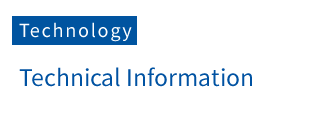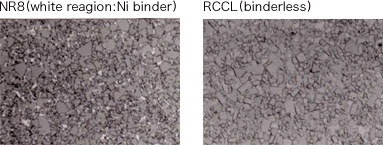
Japan is recognized as using some of the most advanced technology available in many fields, and ceramics, powder metallurgy and cemented carbides are no exception. So maybe it makes sense to see what products and technologies lead the market in Japan. About 60“ of the market there (production volume basis) is held by RCCL products. Corrosion resistance in cemented carbides has a strong correlation to the corrosion resistace of the ferrous binder, and the development of RCCL was designed to enhance corrosion resistance by eliminating this binder. It was believed then that no cemented carbide could be sintered without a binder, but an intensive R&D project found that binderless cemented carbides could be sintered through special pulverizing and mixing techniques combined with sintering at an unusually high temperature and a special sintering atmosphere. This was the first manufacture of a binderless cemented carbide in the world, and is covered by Japanese patents 1381323, 1381324 and -1385676.
| Shares by Grade (Japan Domestic Market) | |
|---|---|
| Grade | Production Volume Share |
| Binderless (RCCL) | 60 % |
| Co binder | 30 % |
| Ni binder (NR8) | 10 % |
This cemented carbide was a type of ceramic (SiC) material, and shattered existing preconceptions by exhibiting corrosion resistance close to that of SiC. Strength was about two to three times that of SiC, in the 1.0 to 1.2GPa range, while hardness was HRA 93.5, or about the same as SiC. Its excellent characteristics led to its rapidly becoming the major material in the market following its release in the 1970s. Mechanical seals in process pumps are exposed to extremely corrosive environments, and also require maintenance-free implementation, Leading to RCCL application in seal rings. Likewise, the material is widely used as mechanical seals for cooling water pumps in nuclear power plants because of the high reliability requirements.
| Comparative Characteristics of RCCL | ||||
|---|---|---|---|---|
| Grade | Density(g/cm3) | Hardness(HRA) | TRS crm(GPa) | Young's Modulus E(GPa) |
| NR8 | 14.8 | 88.5 - 90.5 | 2.3 | 600 |
| RCCL | 14.7 | 92.5 - 94.0 | 1.0 | 640 |
RCCL currently accounts for about 60“ of the cemented carbide seal ring market, and this market share demonstrates that our development program was right on target. In recognition for the development of corrosion resistant cemented carbide materials, developer Nippon Tungsten was awarded the JCCMA(Japan Cemented Carbide Tool Manufacturers' Association) Prize in 1987. If RCCL has won over the majority of the tough Japan market, including nuclear power applications where quality requirements are the most stringent in the world, then maybe you should be considering it to solve your reliability problems.
